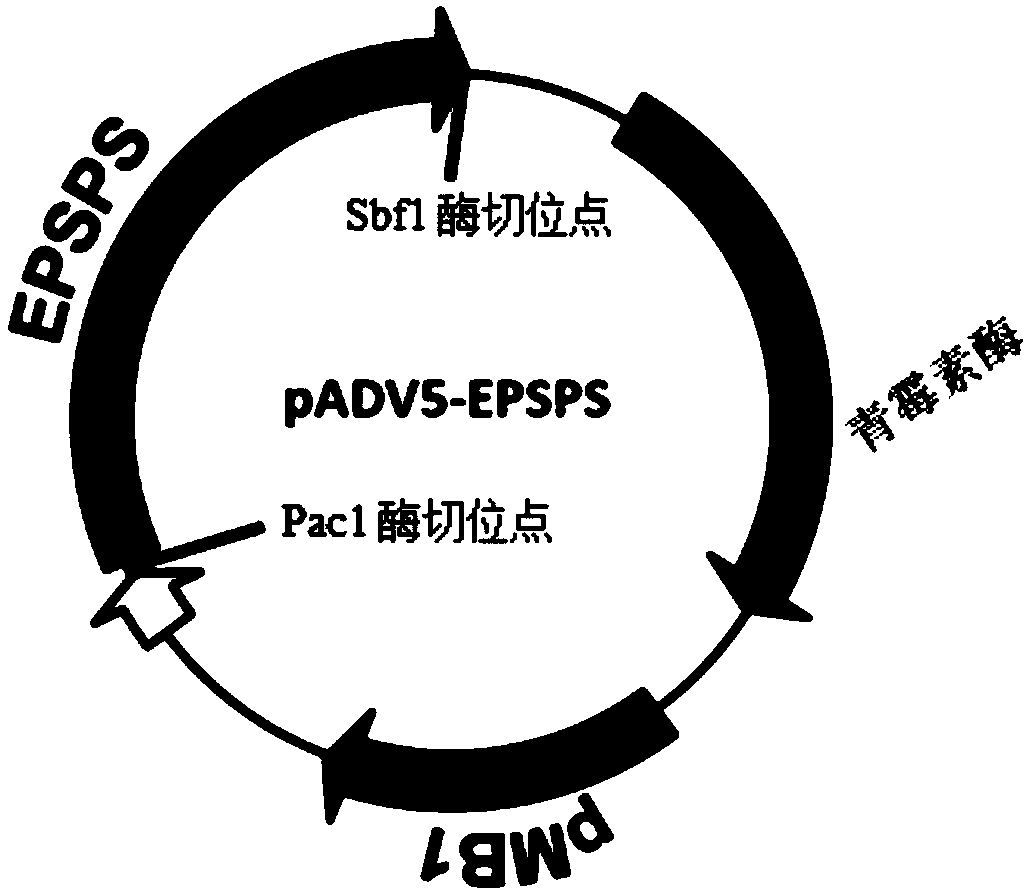Plant EPSPS mutant with A138T mutation, and coding gene and application of mutant
A technology for encoding genes and mutants, applied in the field of genetic engineering, can solve the problem of low acceptance of transgenic crops, and achieve the effects of maintaining the catalytic activity of biological enzymes, improving resistance, and having broad application prospects.
- Summary
- Abstract
- Description
- Claims
- Application Information
AI Technical Summary
Problems solved by technology
Method used
Image
Examples
Embodiment 1
[0095] This embodiment provides a plant EPSPS mutant, which is derived from rice and is rice EPSPS mutant I, which is obtained after mutation from wild-type rice EPSPS (amino acid sequence shown in SEQ ID NO: 5), and its amino acid sequence is as follows: Shown in SEQ ID NO:6.
[0096] Compared with the amino acid sequence of wild-type rice EPSPS shown in SEQ ID NO:5, the rice EPSPS mutant I has a mutation of A155(138)T.
[0097] That is, relative to the wild-type rice EPSPS, the 155th amino acid residue of the rice EPSPS mutant I is mutated from G to A, which corresponds to the 138th position of E. coli EPSPS.
[0098] This embodiment also provides a rice EPSPS mutant I coding gene encoding the above rice EPSPS mutant I, the nucleotide sequence of which is shown in SEQ ID NO:15.
[0099] Both the rice EPSPS mutant I coding gene and the rice EPSPS mutant I provided in the examples of the present invention can be obtained by chemical synthesis.
Embodiment 2
[0101] This embodiment provides a plant EPSPS mutant, which is derived from rice and is rice EPSPS mutant II, which is obtained after mutation from wild-type rice EPSPS (amino acid sequence shown in SEQ ID NO: 5), and its amino acid sequence is as follows: Shown in SEQ ID NO:7.
[0102] Compared with the amino acid sequence of wild-type rice EPSPS shown in SEQ ID NO:5, the rice EPSPS mutant II has two mutations, G111(96)A and A155(138)T.
[0103] That is, if Figure 5 as shown ( Figure 5 Partial results of the amino acid sequence alignment of Escherichia coli EPSPS, rice EPSPS mutant II and wild-type rice EPSPS are shown, in the figure: Ec-EPSPS WT represents Escherichia coli EPSPS; Os-EPSPS M represents rice EPSPS mutant II; Os-EPSPS WT represents wild-type rice EPSPS), relative to wild-type rice EPSPS, the 111th amino acid residue of rice EPSPS mutant II is mutated from G to A, and this site corresponds to Escherichia coli EPSPS (SEQ ID NO :1) at the 96th position; the 1...
Embodiment 3
[0107] This embodiment provides a plant EPSPS mutant, which is derived from corn and is a corn EPSPS mutant, which is obtained by mutation of wild-type corn EPSPS (amino acid sequence shown in SEQ ID NO: 12), and its amino acid sequence is shown in SEQ ID NO: 12. ID NO:13.
[0108] With respect to the amino acid sequence of the wild-type corn EPSPS shown in SEQ ID NO: 12, the corn EPSPS mutant has K94(85)I, G105(96)A, P110(101)S and A149(138)T4 a mutation.
[0109] That is, if Image 6 as shown ( Image 6 Partial results of the amino acid sequence alignment of Escherichia coli EPSPS, maize EPSPS mutant and wild-type maize EPSPS are shown, in the figure: Ec-EPSPS WT represents Escherichia coli EPSPS; Z-EPSPSM represents maize EPSPS mutant; Z-EPSPS WT represents wild-type corn EPSPS), relative to the wild-type corn EPSPS, the 94th amino acid residue of the corn EPSPS mutant is mutated from K to I, which corresponds to the 85th position of Escherichia coli EPSPS; the 105th ami...
PUM
 Login to View More
Login to View More Abstract
Description
Claims
Application Information
 Login to View More
Login to View More - R&D
- Intellectual Property
- Life Sciences
- Materials
- Tech Scout
- Unparalleled Data Quality
- Higher Quality Content
- 60% Fewer Hallucinations
Browse by: Latest US Patents, China's latest patents, Technical Efficacy Thesaurus, Application Domain, Technology Topic, Popular Technical Reports.
© 2025 PatSnap. All rights reserved.Legal|Privacy policy|Modern Slavery Act Transparency Statement|Sitemap|About US| Contact US: help@patsnap.com



